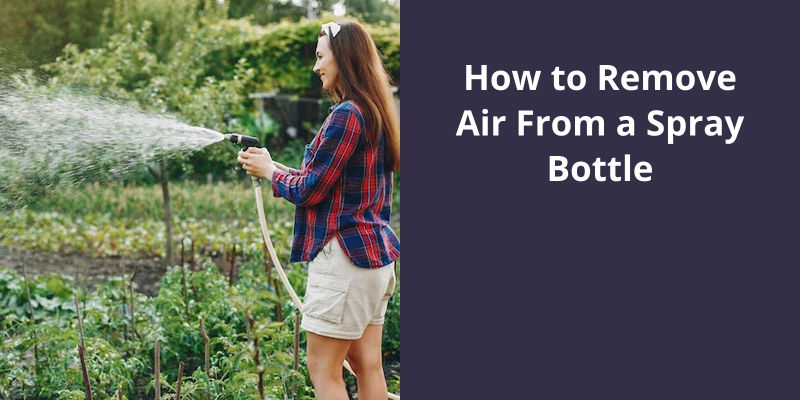A spray bottle is a versatile tool used for various purposes, including cleaning, gardening, and personal care. However, one common issue that can arise with spray bottles is the presence of air inside, which can hinder the proper functioning of the device. Air bubbles inside the bottle can prevent a continuous and consistent spray, leading to frustration and inefficiency. So, how do you get air out of a spray bottle? In this article, we will explore several methods that can help you remove air from a spray bottle and ensure smooth, uninterrupted spraying. Whether you’re a professional cleaner, a gardening enthusiast, or someone who just wants their perfume sprayer to work correctly, these techniques will provide you with practical solutions to eliminate air bubbles and optimize your spray bottle's performance. From simple tricks like tapping the bottle to more advanced techniques such as purging the air through the nozzle, we will cover various approaches so that you can choose the one that suits your situation best. Say goodbye to those frustrating air bubbles and hello to a fully-functioning, air-free spray bottle!

How Do You Fix a Clogged Spray Bottle?
How do you fix a clogged spray bottle? One effective method is to use warm water. If you suspect that your spray bottle is clogged, begin by removing the top and placing the tubing, with the nozzle still attached, into a cup of hot water. Next, pump the spray top repeatedly until you notice that water is spraying out effortlessly. This process helps to unclog any blockages that may be inhibiting the normal flow of liquid. Once you’re satisfied with the mechanism, simply place the top back onto the bottle and resume using it as usual.
Alternatively, you can try using a pin or needle to manually clear any obstructions. Carefully insert the sharp end of the pin or needle into the nozzle opening and gently move it around to dislodge any debris or residue that may be causing the clog. Be sure to exercise caution while doing this to avoid damaging the nozzle or injuring yourself. Once you’ve cleared the blockage, run warm water through the nozzle to flush out any remaining particles.
In some cases, the clog may be caused by a dried-up residue from the liquid you previously used in the bottle. To prevent this from happening, it’s important to thoroughly clean and rinse the bottle after each use. This will help remove any remaining residue and minimize the risk of clogs forming. Additionally, storing the bottle in a cool, dry place can also help prevent clogs caused by exposure to excessive heat or humidity.
Remember, regular maintenance and proper cleaning are essential to keep your spray bottle in optimal condition. By following these simple steps and being proactive in preventing clogs, you can ensure that your spray bottle functions smoothly and effectively for all your needs.
When faced with a stubborn spray can that refuses to spray, there are a few simple steps you can take to troubleshoot the issue. First, try holding the can upside down and spraying, as this can often release built-up pressure. If that doesn’t work, removing the nozzle and inspecting it for any clogs or build-up might do the trick. Use a sharp object like a pin to clear any obstructions, or consider giving the nozzle a thorough cleaning by soaking it in water.
What to Do When a Spray Can Won’t Spray?
When faced with a stubborn spray can that refuses to spray, there are a few tricks you can try to get it working again. One effective method is to hold the can upside down and spray. This simple action can help release some of the pressure that may be preventing the spray from coming out. By inverting the can, the remaining product inside the can forcefully pushes against the nozzle, potentially dislodging any blockages and allowing the spray to flow freely.
If holding the can upside down doesn’t do the trick, it may be worth removing the nozzle altogether. Sometimes, there can be a build-up of matter around the nozzle, causing it to clog. To remove this blockage, you can use a sharp object like a pin to scrape away any debris. Alternatively, you can try washing the nozzle in water to eliminate any obvious build-up that may be obstructing the spray.
Another method to address a spray can that won’t spray is to shake the can vigorously. This shaking motion helps to mix the contents, ensuring that the propellant and product are properly combined. Sometimes, the ingredients can separate over time, leading to a malfunctioning spray mechanism. By giving the can a good shake, you reestablish a proper mixture, improving the chances of the spray working correctly.
In some cases, the issue may lie with the spray button itself. To address this, you can try pushing the button repeatedly while ensuring it moves freely. This action can help dislodge any potential blockages or sticky residue that may be impeding the spray.
If these methods don’t solve the problem, it may be necessary to consult the manufacturers instructions or contact their customer support for further assistance. Overall, troubleshooting a non-spraying spray can involves a combination of simple techniques to remove blockages, release pressure, and ensure the proper functioning of the spray mechanism.
-Alternative Methods to Apply Spray Paint or Other Products When a Can Won’t Spray
- Check the nozzle for clogs and clean it if necessary.
- Try holding the can upright and shaking it vigorously to mix the contents.
- Remove the nozzle and soak it in warm soapy water to dissolve any dried paint.
- Use a pin or needle to unclog the nozzle if soaking doesn’t work.
- Transfer the paint to a new spray can with a functioning nozzle.
- Consider using a spray gun or airbrush for more controlled application.
- Dilute the paint with an appropriate thinner or solvent to improve sprayability.
- Apply the paint with a brush or roller if spray application isn’t feasible.
- Opt for aerosol trigger sprayers for easier application and better control.
- Seek professional help or advice if the product still won’t spray.
One common issue when using a pump sprayer is a clogged nozzle, which can impede the flow of liquid or result in an uneven spray pattern. However, cleaning a clogged pump sprayer is a simple process that can be easily done with a few basic tools. First, remove the nozzle from the spray wand, then use tools to remove any material clogging the nozzle. Next, clear away any dirt and debris by spraying a water stream from a bottle. Use a toothpick to clean the nozzle orifice and a toothbrush to clean the screen. Rinse the nozzle parts using the spray bottle, then reassemble the nozzle. Finally, put all your supplies back into the bag and seal it for future use.
How Do You Clean a Clogged Pump Sprayer?
When it comes to cleaning a clogged pump sprayer, there are several steps you can take to effectively remove any debris or blockages. The first step is to remove the nozzle from the spray wand. This will allow you to access the interior parts of the nozzle and properly clean them. Once the nozzle is removed, you can use specialized tools designed for this purpose to remove any material that may be clogging the nozzle. These tools can be inserted into the nozzle openings to gently dislodge and remove any debris.
After using the tools, it’s important to clear away any remaining dirt or debris by using the spray bottles water stream. Simply aim the nozzle into a sink or other appropriate area and press the trigger, allowing the water to flow through the nozzle and flush out any remaining particles.
To ensure the nozzle is thoroughly cleaned, you can use a toothpick to clean the nozzle orifice. Gently insert the toothpick into the orifice and gently scrape away any residue or blockages.
For the screen, which is typically located on the inside of the nozzle, a toothbrush can be used to effectively clean it. Gently scrub the screen with the toothbrush, being sure to remove any dirt or debris that may have accumulated.
Once all the parts of the nozzle have been cleaned, it’s important to rinse them thoroughly using the spray bottle. This will ensure that any remaining cleaning solution or residue is removed. Finally, reassemble the nozzle by putting the parts back together. Make sure that everything fits snugly and securely.
To keep your cleaning supplies organized and ready for use, it’s always a good idea to put them back into a bag and seal it. This will prevent any dust or other debris from getting into the tools and nozzle, ensuring that they’re ready for use the next time you need to clean your pump sprayer.
One common frustration many people experience with aerosol cans is when they fail to spray properly. If you find yourself struggling to engage the pump, feeling excessive resistance or tension, you may be dealing with a clogged aerosol can. According to experts like Poepping, this is a common issue that can be easily addressed. Let’s explore some possible reasons why your aerosol isn’t spraying and learn how to fix it.
Why Does My Aerosol Not Spray?
There can be several reasons why your aerosol spray bottle might not be spraying properly. One common issue is a clogged pump. If you find that the pump is difficult to engage and there’s a lot of resistance or tension when you try to push down on the spray top, it’s a clear indication of a clog. This can be caused by a variety of factors, including dried-up product residue or debris that’s accumulated in the nozzle or pump mechanism.
To resolve this issue, you can try a few simple techniques to remove the air and unclog the spray bottle. Firstly, you can try soaking the nozzle in warm soapy water for a few minutes. This can help to loosen any dried-up residue and facilitate the smooth flow of air and product. After soaking, make sure to rinse the nozzle thoroughly with clean water to remove any remaining debris.
If the clog persists, you can also try using a pin or a needle to gently unclog the nozzle. Be careful not to damage the nozzle or enlarge the opening too much, as this can affect the spray pattern and make it less effective. Gently insert the pin or needle into the nozzle and wiggle it around to dislodge any blockage. Then, rinse the nozzle again to remove any loosened debris.
You can find compressed air cans specifically designed for cleaning electronic equipment or keyboards. Hold the can upright and direct a short burst of air into the nozzle to dislodge any blockage. Make sure to do this in a well-ventilated area and be cautious not to get the product on your skin or eyes.
If none of these methods work, it might be worth considering replacing the spray top or pump mechanism altogether. Over time, these components can wear out and become less effective, leading to clogs and issues with spraying. In such cases, visit your local hardware store or contact the manufacturer for replacement parts or further guidance.
Remember to always refer to the products instructions and safety guidelines before attempting any maintenance or repairs.
How to Properly Clean and Maintain Aerosol Spray Bottles to Prevent Clogs
- Use warm water to rinse the spray bottle before each use.
- Remove the nozzle and dip it in warm, soapy water for a few minutes.
- Scrub the nozzle with a small brush to remove any residue or clogs.
- Rinse the nozzle thoroughly with warm water to ensure all soap is removed.
- Fill the spray bottle with warm water and pump the nozzle a few times to flush out any remaining debris.
- For stubborn clogs, try using a needle or pin to clear the nozzle opening.
- After each use, empty any leftover liquid from the bottle and rinse it with warm water.
- Allow the spray bottle and nozzle to air dry completely before reassembling.
- Store the clean, dry spray bottle in a cool and dry place to prevent future clogs.
- Repeat these steps regularly to maintain a clog-free aerosol spray bottle.
Source: How to Unclog a Spray Bottle and Aerosol Can – Martha Stewart
Conclusion
By following these techniques, such as adjusting the nozzle, priming the pump, or using alternative filling methods, users can ensure a consistent and uninterrupted flow of liquid without any obstructions caused by trapped air. Whether it’s for cleaning, gardening, or personal care purposes, eliminating air from the spray bottle allows for an optimal spraying experience, ensuring that the desired liquids are dispensed effectively and efficiently.





